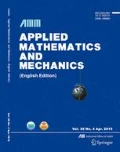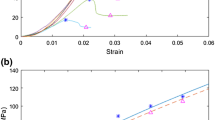Abstract
An analytical formulation is developed to investigate the stability of a deep, inclined borehole drilled in a geologic medium and subjected to an internal pressure and a non-hydrostatic stress field. The formulation consists of a three-dimensional (3-D) analysis of stresses around a borehole, combined with internal pressurization of the borehole to obtain an approximate solution of the overall stress distribution. The orientation of the borehole, the in-situ stresses and bedding plane can all be arbitrarily related to each other to represent the actual field situations. Both tensile failure and shear failure potentials of a borehole are investigated. The failure criteria applied assume that when the least principal stress exceeds the strength of the formation in tension, a tensile failure occurs. Shear failure is represented using the modified Drucker-Prager failure criterion for anisotropic materials. A parametric study is carried out to assess the effect of material anisotropy, bedding plane inclination and in-situ stress conditions on borehole stability. Results of the parametric study indicate that wellbore stability is significantly influenced by a high borehole inclination, high degree of material anisotropy, in-situ stress conditions and high formation bedding plane inclination.
The stability of a borehole in an elasto-plastic medium is also investigated. In order to evaluate the extent of the plastic zone around a borehole and the effect of anisotropy of the material on this plastic zone, a mathematical formulation is developed using theories of elasticity and plasticity. The borehole is assumed to be vertical, subjected to hydrostatic stresses, and drilled in a transversely isotropic geologic medium. A parametric study is carried out to investigate the effect of material anisotropy on the plastic behavior of the geologic medium. Results indicate that the stress distribution around a borehole, the extent of the plastic zone, and the failure pressure are influenced by the degree of material anisotropy and value of in-situ overburden stresses. It was observed that the borehole becomes less stable as the degree of anisotropy of the geologic medium increases.
Similar content being viewed by others
References
Aadnoy B S. Continuum mechanics analysis of the stability of boreholes in anisotropic rock formations[D]. Ph D Thesis. Norway: Norwegian Institute of Technology, University of Trondheim, 1987.
Ong S H. Borehole stability [D]. Ph D Dissertation. Norman OK: University of Oklahoma, 1994.
Lekhnitskii S G.Theory of Elasticity of an Anisotropic Body [M]. Moscow: Mir Publishers, 1981.
Amader B. Rock anisotropy and theory of stress measurements[A]. In: Brebbia, Orszag Eds.Lecture Notes in Engineering[C]. Springer Verlag, 1983.
Aadnoy B S. A complete elastic model for fluid-induced and in-situ generated stresses with the presence of a borehole[J].Energy Sources, 1987,9:239–259.
Bradley W B. Failure of inclined boreholes[J].Journal of Energy Resources Technology Trans, ASME, 1979,101:232–239.
Hsiao C. Growth of plastic zone in porous medium around a wellbore[J].Offshore Technology Conference, 1988,26:439–448.
Westergaard H M. Plastic state of stresses around a deep well[J].Journal of the Boston Society of Civil Engineers, 1940,27(1):1–5.
Gnirk P F. The mechanical behavior of uncased wellbores situated in elastic/plastic media under hydrostatic stress[J].Society of Petroleum Engineers Journal, 1972,12:49–59.
Risnes R, Bratli R K, Horsud P. Sand stresses around a wellbore[J].Society of Petroleum Engineers Journal, 1982,22:883–898.
Biot M A. Theory of elasticity and consolidation for a porous anisotropic solid[J].Journal of Applied Physics, 1941,26(2):182–185.
Yew C H, Li Y. Fracture of a deviated well[J].SPE Production Engineering, 1988,3: 429–437.
Chen Dar-Hao. Three dimensional testing and constitutive modeling of coal for analysis of ground subsidence due to mining [D]. M S Thesis. Norman OK: University of Oklahoma, 1992.
Drucker D C, Prager W. Soil mechanics and plastic analysis or limit design[J].Quart Appl Math, 1992,10:157–165.
Faruque M O, Chang C. New cap model for failure and yielding of pressure sensitive materials[J].Journal of Engineer Mechanics Division, ASCE, 1986,112:1041–1053.
Najjar Y M. Constitutive modelling and finite element analysis of ground subsidence due to mining[D]. Ph D Thesis. Norman OK: University of Oklahoma, 1990.
Lama R D, Vutukuri V S.Handbook on Mechanical Properties of Rocks[M]. Series on Rock and Soil Mechanics Vol. II. Ohio: Trans Tech Publications, 1978.
Infante E F, Chenevert M E. Stability of boreholes drilled through salt formations displaying plastic behavior[J].Society of Petroleum Engineers Drilling Engineering (SPEDE), 1989,4:57–65.
Gupta D J. Stability of boreholes in a transversely isotropic geologic medium[D]. M S Thesis. Norman OK: University of Oklahoma, 1994.
Aadnoy B S. Stability of highly inclined boreholes[J].SPEDE, 1987,2:364–374.
Aadnoy B S. Modeling of the stability of highly inclined boreholes in anisotropic rock formations[J].SPEDE, 1988,2:259–267.
Aadnoy B S. Method for fracture-gradient prediction for vertical and inclined boreholes [J].SPEDE, 1989,4:99–103.
Aadnoy B S. Stresses around horizontal boreholes drilled in sedimentary rocks[J].Journal of Petroleum Science and Engineering, 1989,2:349–360.
Aadnoy B S. Effects of reservoir depletion on borehole stability[J].Journal of Petroleum Science and Engineering, 1991,5:57–61.
Bratli R K, Risnes R. Stability and failure of sand arches[J].Society of Petroleum Engineers Journal, 1981,21:236–248.
Tsai S W, Wu E M. A general theory of strength for anisotripic materials[J].J Composite Material, 1971,5:58–80.
Author information
Authors and Affiliations
Additional information
Communicated by Chien Weizang
Rights and permissions
About this article
Cite this article
Gupta, D., Zaman, M. Stability of boreholes in a geologic medium including the effects of anisotropy. Appl Math Mech 20, 837–866 (1999). https://doi.org/10.1007/BF02452483
Received:
Issue Date:
DOI: https://doi.org/10.1007/BF02452483




